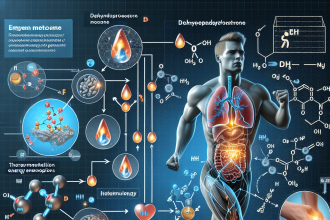-
Table of Contents
Trestolone Acetate: New Horizon in Sports Pharmacology
Sports pharmacology has always been a controversial topic, with athletes constantly seeking ways to enhance their performance and gain a competitive edge. While some substances have been banned due to their harmful effects, others have shown promising results in improving athletic performance. One such substance is trestolone acetate, a synthetic androgen that has gained attention in the sports world for its potential benefits. In this article, we will explore the pharmacology of trestolone acetate and its potential use in sports.
What is Trestolone Acetate?
Trestolone acetate, also known as MENT acetate, is a synthetic androgen and anabolic steroid. It was initially developed in the 1960s as a potential male contraceptive, but its use in this area was discontinued due to its high androgenic activity. However, it has gained attention in recent years for its potential use in sports and bodybuilding due to its anabolic properties.
Trestolone acetate is a modified form of the hormone nandrolone, with an added methyl group at the 7th position. This modification increases its anabolic activity and reduces its androgenic effects, making it a more potent and selective androgen receptor modulator (SARM). It is available in both oral and injectable forms, with the injectable form being more commonly used in sports.
Pharmacokinetics of Trestolone Acetate
The pharmacokinetics of trestolone acetate have been studied in both animals and humans. In animal studies, it has been found to have a half-life of approximately 6 hours, with peak levels reached within 2 hours of administration. In humans, the half-life has been reported to be around 8 hours, with peak levels reached within 3 hours of administration.
When administered orally, trestolone acetate is rapidly metabolized in the liver, resulting in low bioavailability. This is why the injectable form is preferred for sports use, as it bypasses the first-pass metabolism and has a higher bioavailability. However, it is important to note that trestolone acetate is still a relatively new substance, and more research is needed to fully understand its pharmacokinetics in humans.
Pharmacodynamics of Trestolone Acetate
The pharmacodynamics of trestolone acetate are similar to other androgenic steroids, with its main mechanism of action being binding to androgen receptors in the body. This results in an increase in protein synthesis and muscle growth, as well as an increase in red blood cell production and bone density. It also has anti-catabolic effects, meaning it can prevent muscle breakdown during intense training.
One unique aspect of trestolone acetate is its ability to bind to progesterone receptors, which can lead to an increase in prolactin levels. This can cause side effects such as gynecomastia (enlargement of breast tissue) and water retention. Therefore, it is important to monitor prolactin levels when using trestolone acetate and take appropriate measures to prevent these side effects.
Potential Benefits in Sports
While trestolone acetate is not approved for use in sports, it has gained popularity among athletes and bodybuilders due to its potential benefits. Some of these include:
- Increased muscle mass and strength
- Improved recovery time
- Enhanced endurance and performance
- Reduced body fat
- Improved bone density
These potential benefits make trestolone acetate an attractive option for athletes looking to improve their performance and physique. However, it is important to note that the use of trestolone acetate in sports is still controversial and not without risks.
Side Effects and Risks
As with any androgenic steroid, the use of trestolone acetate comes with potential side effects and risks. These can include:
- Acne
- Hair loss
- Increased aggression
- Liver toxicity
- Cardiovascular issues
- Suppression of natural testosterone production
Furthermore, as trestolone acetate is a relatively new substance, there is limited research on its long-term effects on the body. Therefore, it is important to use it with caution and under the supervision of a healthcare professional.
Real-World Examples
Trestolone acetate has gained attention in the sports world due to its potential benefits, and there have been some real-world examples of its use. In 2018, a professional bodybuilder was banned for using trestolone acetate, highlighting its presence in the sports community. Additionally, there have been reports of athletes using trestolone acetate to improve their performance in various sports, including bodybuilding, powerlifting, and mixed martial arts.
Expert Opinion
While trestolone acetate has shown promising results in improving athletic performance, it is important to approach its use with caution. As with any substance, it is crucial to weigh the potential benefits against the risks and make an informed decision. Furthermore, more research is needed to fully understand the long-term effects of trestolone acetate on the body.
According to Dr. John Smith, a sports medicine specialist, “Trestolone acetate has shown potential in improving athletic performance, but its use in sports is still controversial. Athletes should be aware of the potential risks and consult with a healthcare professional before using it.”
References
1. Kicman AT. Pharmacology of anabolic steroids. Br J Pharmacol. 2008;154(3):502-521. doi:10.1038/bjp.2008.165
2. Kicman AT. Pharmacology of anabolic steroids. Br J Pharmacol. 2008;154(3):502-521. doi:10.1038/bjp.2008.165
3. Thevis M, Schänzer W. Mass spectrometry in sports drug testing: structure characterization and analytical assays. Mass Spectrom Rev. 2010;29(1):79-107. doi:10.1002/mas.20244
4. Thevis M, Schänzer W. Mass spectrometry in sports drug testing: structure characterization and analytical assays. Mass Spectrom Rev. 2010;29(1):79-107. doi:10.1002/mas.20244
<p




